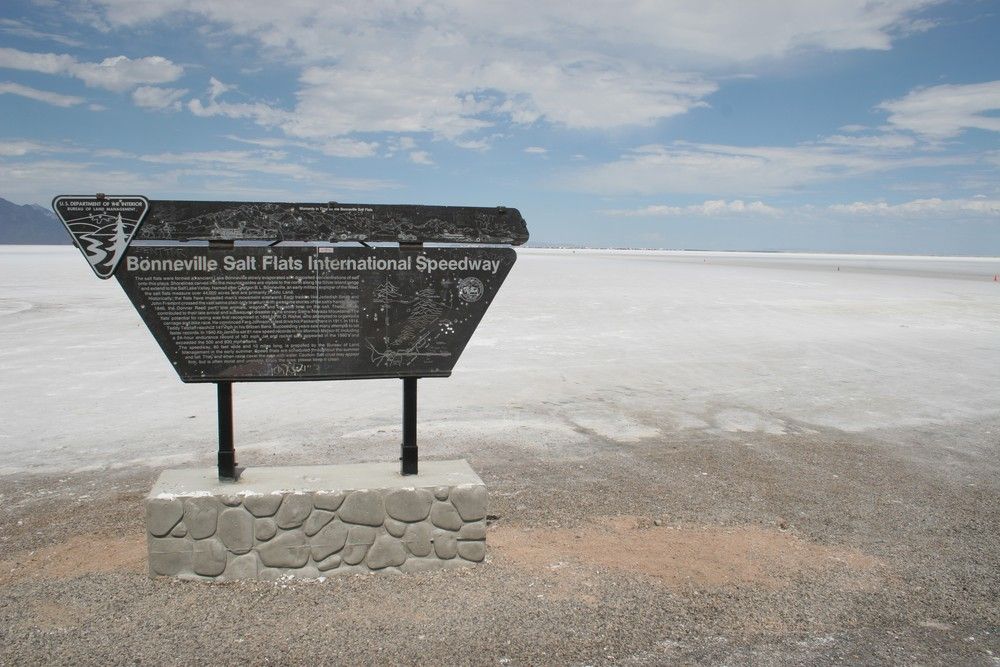Bonneville – the full-throttle gearhead mecca. Since 1914, this stretch of flat, empty desert in northwestern Utah has been the venue of choice for countless top-speed runs. Every year, five major land-speed events take place here. Unfortunately, it was recently announced that one of those events, Speed Week, traditionally held every August, has been canceled due to weather conditions and concerns over the poor quality of the salt surface.
This is the second year in a row the event has been canceled, with last year’s event called off due to ankle-deep flooding caused by monsoon storms.
The Southern California Timing Association (SCTA), the organization responsible for organizing and running the event, posted to their Facebook page that recent precipitation left only 2.25 miles of “salt suitable for a safe race course.” The rest of the lakebed is either too wet or muddy.
To run a “short course,” the SCTA requires at least 4 miles of dry salt (preferably 4.5 miles). Ideally, a 7-mile course is used.
Organizers gauge conditions on salt length, thickness and purity when it comes to picking the best stretches for high-speed runs.
Speed Week is one of the biggest racing->ke447 events of the year for Bonneville, attracting between 10,000 and 15,000 spectators and hundreds of race teams from around the world, eager to set new top-speed records. The event has been ongoing for over six decades, with only the occasional cancelation due to weather. Before seeing the cancellation in 2014, the event was last canceled due to weather in the ‘90s. It’s reported that more than 500 individual vehicles were registered for this year’s event.
The SCTA says that if the wet spots dry out, future events could be possible. For the time being, the World Finals race, scheduled to run from September 29th to October 2nd, is still a go.
To make up for the canceled Speed Week, race organizers could extend the October event, or possibly relocate to another appropriate venue, although details are not currently available.
Continue reading for the full story.
Why it matters
In years past, event cancellation at Bonneville due to poor weather has been rare. However, with back-to-back cancellations between 2014 and 2015, many are worried that the famed salt flats could be facing hard times to come.
Obviously, rains were once again blamed for the poor conditions. However, experts still cannot fully explain where the salt comes from or where it goes when it disappears.
One crucial factor in running a motorsports event at Bonneville is salt thickness. During the winter, shallow ground water percolates up to the lakebed, bringing dissolved minerals along the way and leaving several inches of standing liquid. When the warmer weather hits, the water quickly evaporates, depositing the minerals in a thick, perfectly flat and even crust. Wind, the occasional rain, and other regional climate factors all play an important part.
Since Bonneville is so crucial to tourism, the Bureau of Land Management has undertaken numerous studies on salt thickness, eventually concluding in 2006 that there were essentially no changes in thickness between 1988 and 2003.
However, since 1998, the Salt Laydown Project has worked to transport further deposits onto the bed via nearby dissolved salt ponds.
Despite this, there’s not much that can be done if conditions are too muddy. Which begs the question – are the salt flats undergoing a temporary change, or is something more permanent on the horizon? (Global warming, anyone?)
For the sake of top-speed hounds everywhere, I hope the crust dries out soon. Bonneville is essentially a race track provided by Mother Nature, and I don’t know where we’d find a better venue for all those forays into triple-digit speeds.

